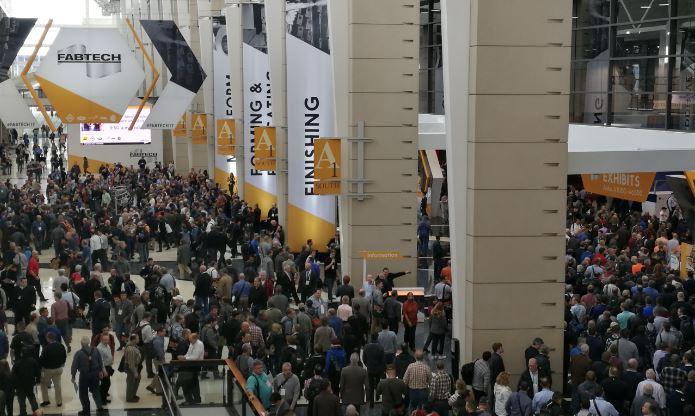Senior Editor
- FMA
- The Fabricator
- FABTECH
- Canadian Metalworking
Categories
- Additive Manufacturing
- Aluminum Welding
- Arc Welding
- Assembly and Joining
- Automation and Robotics
- Bending and Forming
- Consumables
- Cutting and Weld Prep
- Electric Vehicles
- En Español
- Finishing
- Hydroforming
- Laser Cutting
- Laser Welding
- Machining
- Manufacturing Software
- Materials Handling
- Metals/Materials
- Oxyfuel Cutting
- Plasma Cutting
- Power Tools
- Punching and Other Holemaking
- Roll Forming
- Safety
- Sawing
- Shearing
- Shop Management
- Testing and Measuring
- Tube and Pipe Fabrication
- Tube and Pipe Production
- Waterjet Cutting
Industry Directory
Webcasts
Podcasts
FAB 40
Advertise
Subscribe
Account Login
Search
Laser cutting at FABTECH: Not just about inches-per-minute
Big picture thinking from the show floor
- By Tim Heston
- November 10, 2017

Crowds flocked to FABTECH to Chicago this week, looking for machines, software, and strategies to increase capacity.
In the late 1990s and early 2000s I recall going to FABTECH® every year, standing next to laser cutting machines, and talking with folks about kilowatts and inches per minute (IPM). A few years later, the IPM talk ramped up big time in the early days of fiber lasers, and for good reason: The fiber laser’s cutting speed on thin stock was simply astounding.
Then at FABTECH® this week in Chicago, Nov. 6-9, I visited several booths with big, impressive, amazingly fast laser cutting machines, then asked a representative about IPMs. Many said that speed really wasn’t a factor anymore. And it makes sense. Who really cares how quickly a laser can cut or move between cuts when neither people nor automation can keep up with the machine?
Hence the show’s heavy focus on new ways to automate material movement to and from the laser; about the material forming and offloading options with punches and punch/laser combination systems; about part sorting and making sure blanks flow quickly downstream; about new ways of bending to increase throughput of a high variety of parts (robotics, automatic tool changing); about faster ways to weld (including the use of collaborative robots, as well as laser welding); and about software, the cloud, operational visibility (knowing where all jobs are all the time), and the ideas behind Industry 4.0 tying it all together.
But this really is only half the story. The other half is about strained capacity and maintaining cut quality. Many attendees at FABTECH® told me that on-time delivery rates are faltering this year. OEMs hold less inventory, and—thanks to an improving economy—are demanding more work in less time. Fabricators skip preventive maintenance (PMs) simply because they feel they don’t have the time to shut machines down for eight to 12 hours.
This leads to CO2 lasers cutting machines with laser gas bottles nearly empty; fiber lasers making poor cuts thanks to dirty cover slides in the cutting head; and people not cleaning or maintaining optics as they should. Quality suffers. Heat sensors within machines go off, which spurs reactive maintenance, which reduces cutting capacity and starves the rest of the shop of work. That’s not a good situation. Now, those cutting IPMs are effectively at zero.
If expenses remain the same (number of employees/payroll, facility costs, etc.) and a laser shortens cutting time by half—and yet the job doesn’t ship in less time—nothing changes, and the shop doesn’t make any more or less money than it did before.
It’s not about IPMs or the power of this or that machine; it’s about consistent flow of quality work throughout the shop, from order to ship. That was what this year’s FABTECH® was all about.
subscribe now

The Fabricator is North America's leading magazine for the metal forming and fabricating industry. The magazine delivers the news, technical articles, and case histories that enable fabricators to do their jobs more efficiently. The Fabricator has served the industry since 1970.
start your free subscriptionAbout the Author

Tim Heston
2135 Point Blvd
Elgin, IL 60123
815-381-1314
Tim Heston, The Fabricator's senior editor, has covered the metal fabrication industry since 1998, starting his career at the American Welding Society's Welding Journal. Since then he has covered the full range of metal fabrication processes, from stamping, bending, and cutting to grinding and polishing. He joined The Fabricator's staff in October 2007.
Related Companies
- Stay connected from anywhere

Easily access valuable industry resources now with full access to the digital edition of The Fabricator.

Easily access valuable industry resources now with full access to the digital edition of The Welder.

Easily access valuable industry resources now with full access to the digital edition of The Tube and Pipe Journal.
- Podcasting
- Podcast:
- The Fabricator Podcast
- Published:
- 04/16/2024
- Running Time:
- 63:29
In this episode of The Fabricator Podcast, Caleb Chamberlain, co-founder and CEO of OSH Cut, discusses his company’s...
- Industry Events
16th Annual Safety Conference
- April 30 - May 1, 2024
- Elgin,
Pipe and Tube Conference
- May 21 - 22, 2024
- Omaha, NE
World-Class Roll Forming Workshop
- June 5 - 6, 2024
- Louisville, KY
Advanced Laser Application Workshop
- June 25 - 27, 2024
- Novi, MI































